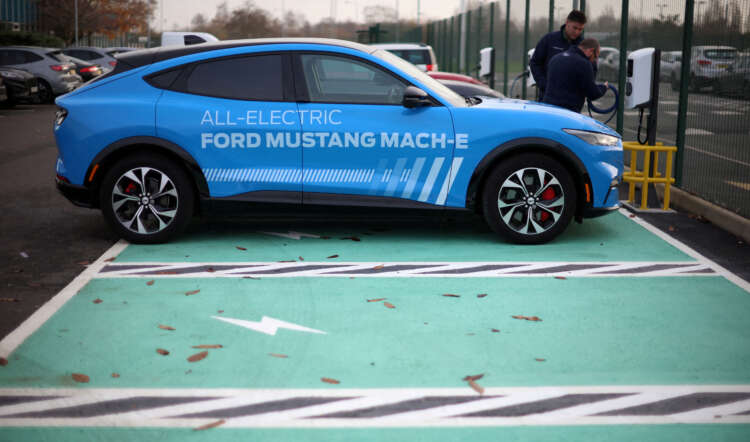
By Joseph White and Paul Lienert
DETROIT (Reuters) -Ford Motor Co on Thursday said quarterly profits fell and the automaker predicted a difficult year ahead, sending its shares down after the bell as investors were disappointed following this week’s robust report from rival General Motors Co.
Ford blamed chip shortages and other supply chain issues and production “instabilities” that raised costs, along with lower-than-expected volumes. Ford shares dropped more than 6% in after-market trading.
“We should have done much better last year,” Ford CEO Jim Farley said in a statement. “We left about $2 billion in profits on the table that were within our control.”
In an analyst call, Farley added: “We have deeply entrenched issues in our industrial system,” saying “this has been humbling for both me and my team.”
Ford forecast flat to lower pre-tax profits for 2023, as well as greatly reduced free cash flow, and signaled an accelerated effort to slash costs.
GM shares jumped on Tuesday, and Ford’s shares rose slightly after GM reported higher net income for the fourth quarter, forecast stronger-than-expected earnings for 2023 and said it would cut $2 billion in costs.
In a briefing late Thursday, Ford Chief Financial Officer John Lawler said “2023 is a pivotal year for us as we reshape the company.” Some aspects of Ford’s overhaul are “lagging and need more work,” he said.
“In the simplest terms, we need to improve quality and lower costs now,” Lawler reporters.
He also predicted a “mild” recession for the U.S. market in 2023, compared with a more upbeat economic forecast by GM.
Lawler said Ford’s fourth-quarter sales volumes were 100,000 vehicles short of expectations. He blamed most of that on the company’s inability to get enough chips for its cars. Lawler said it was “hand-to-hand combat” to get chips and capacity was still constrained for the larger, older chips used in the auto sector.
He said Ford faces $5 billion in higher costs this year, but has kept the mid-range of its profit guidance flat with 2022. Ford had previously set a target of cutting $3 billion in costs from operations, but Lawler said the company will be “very aggressive” in reducing expenses in its manufacturing and supply chain operations, adding, “Everything’s on the table.”
Quality issues continued to drag Ford’s results. Lawler said Ford should be able to reduce warranty costs by $2 billion annually.
Lawler said Ford intends to return 40-50% of free cash flow to shareholders this year. But the company expects adjusted free cash flow to fall to about $6 billion in 2023 from $9.1 billion last year.
Ford expects full-year adjusted pretax earnings of $9 billion to $11 billion. The company’s 2022 adjusted profit of $10.4 billion was short of Ford’s forecast at the end of the third quarter for $11.5 billion.
Fourth-quarter net income fell to $1.3 billion, from $12.3 billion in the year-earlier period. Revenue climbed to $44 billion, from $37.7 billion the previous year. Adjusted pretax earnings were $2.6 billion, compared with $2.0 billion last year.
(Additionl reporting by Ben Klayman in Detroit; Editing by David Gregorio)


